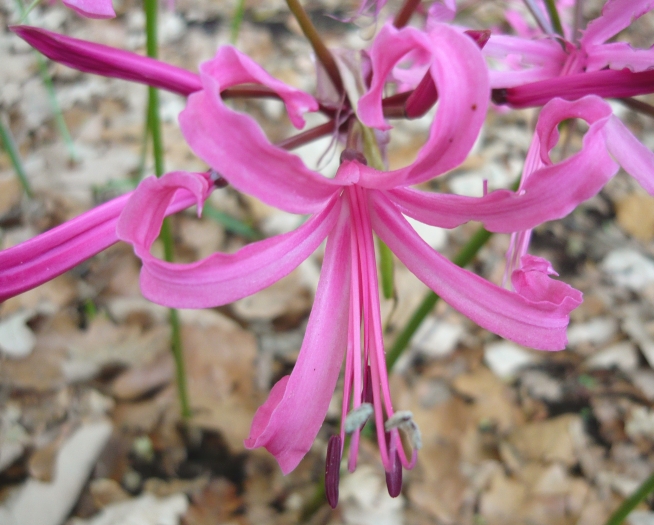Cornish Lily
(Nerine bowdenii)
Cornish Lily (Nerine bowdenii)
/
/

Cillas
CC BY-SA 4.0
Image By:
Cillas
Recorded By:
Copyright:
CC BY-SA 4.0
Copyright Notice:
Photo by: Cillas | License Type: CC BY-SA 4.0 | License URL: https://creativecommons.org/licenses/by-sa/4.0 | Uploader: Cillas | Publisher: Wikimedia Commons | Title: Nerine_bowdenii_HRM2.JPG | Notes: {{Information| |Description = ;Scientific name: ''[[Nipponanthemum nipponicum]]'' {{ja|ハマギク}} Place:Rokko alpine botanical garden |Source = KENPEI's photo |Date = 2008-09-23 |Author = KENPEI |Permission =GFDL,Creative Commons Attribution ShareAli |






















Estimated Native Range
Summary
Nerine bowdenii, commonly known as Cornish Lily, is a deciduous perennial bulb native to South Africa, particularly found in rocky and sandy soils in the mountainous regions. It typically grows to a height of 1-2 feet and a width of 0.3-0.5 feet. The plant is characterized by its strap-shaped leaves and striking, lily-like flowers which are bright pink with frilly tips and appear on leafless stems in late summer to autumn, making them quite showy. The flowers are faintly scented and can add a splash of color to the garden when many other plants are starting to decline.
Cornish Lily is valued for its vibrant pink and red flowers that provide late-season interest in the garden. It is often used in borders, rock gardens, and as a cut flower due to its long vase life. In cultivation, it thrives in full sun and requires medium amounts of water and well-drained soil. While it is quite hardy and can withstand temperatures down to −15 °C (5 °F), it does not perform well in tropical or very humid climates. For best flowering, bulbs should be left undisturbed and allowed to become crowded. Colchicums and cyclamens are recommended as companion plants. Potential problems include bulb rot if the soil is too wet and damage from slugs and snails.CC BY-SA 4.0
Cornish Lily is valued for its vibrant pink and red flowers that provide late-season interest in the garden. It is often used in borders, rock gardens, and as a cut flower due to its long vase life. In cultivation, it thrives in full sun and requires medium amounts of water and well-drained soil. While it is quite hardy and can withstand temperatures down to −15 °C (5 °F), it does not perform well in tropical or very humid climates. For best flowering, bulbs should be left undisturbed and allowed to become crowded. Colchicums and cyclamens are recommended as companion plants. Potential problems include bulb rot if the soil is too wet and damage from slugs and snails.CC BY-SA 4.0
Plant Description
- Plant Type: Bulb
- Height: 1-2 feet
- Width: 0.3-0.5 feet
- Growth Rate: Moderate
- Flower Color: Pink
- Flowering Season: Summer, Fall
- Leaf Retention: Deciduous
Growth Requirements
- Sun: Full Sun
- Water: Medium
- Drainage: Fast
Common Uses
Border Plant, Deer Resistant, Drought Tolerant, Potted Plant, Rabbit Resistant, Rock Garden, Salt Tolerant, Showy Flowers, Street Planting
Natural Habitat
Rocky and sandy soils in the mountainous regions of South Africa
Other Names
Common Names: Cape Flower, Guernsey Lily, Bowden Lily, Nerine
Scientific Names: , Nerine bowdenii, Nerine veitchii,
GBIF Accepted Name: Nerine bowdenii W.Watson